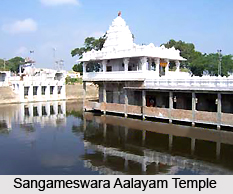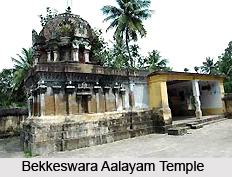 Temples of Mahbubnagar District in Telangana deal with the several ancient and medieval South Indian temples like Sangameswara Aalayam Temple, Uma Maheswari Temple, Bekkeswara Aalayam Temple and many other temples.
Temples of Mahbubnagar District in Telangana deal with the several ancient and medieval South Indian temples like Sangameswara Aalayam Temple, Uma Maheswari Temple, Bekkeswara Aalayam Temple and many other temples.
Mahbubnagar District is the largest district in Telangana. Telangana is a newly formed state in modern India after bifurcated from Andhra Pradesh. It is also lovingly called `Palamooru`. A number of temples braid Mahbubnagar.
Temples of Mahbubnagar District in Telangana further add to the tourism sector of the district. The major pilgrim centres in are Alampur Temple, Manikonda Temple, Wanaparthi Temple, Malleswaram Temple, Somasila temple, Sri Rangpur Temple, Uma Maheswari Temple, Tripurantakam Umamaheshwaram temple, Bekkeswara Aalayam Temple and Nava Brahma Temple on the riverbanks of Tungabhadra. The major dynasties that ruled this place were the Cholas, Kakatiyans, Vijayanagara kings and Nizam Nawabs, proof of ancientness of the beauteous construction of these legendary temples. Lord Shiva rules mostly in the shrines, with exceptions thrown here and there. The spectacular rich heritage of these constructions lay stress on the century old times, dating back to the Ramayana and Mahabharata period with elaborate sculptural works. The region is also popular for its traditional handicrafts and handloom works. The vistas prove that Mahbubnagar served a golden preceding era, an additional profit for tourist development.
Sangameswara Aalayam Temple
Sangameswara Aalayam Temple is located at Kudali, Mahabubnagar which has a deity of Lord Shiva. This temple is located at the confluence of Tungabhadra and Krishna rivers. It was built by the Chalukyas and resembles the Alampur Navabrahmaalayas in architecture. The walls have beautiful carvings of Nataraja, Ardhanareeswara, and Andhakasura samharamurti. Regular prayers are offered. It lies 15 km from Alampur in Mahabubnagar.
Uma Maheswari Temple
This temple was built during the reign of Maurya Chandragupta contains a grand image of Errana, adored in literature. It is a hill temple, built by Kalyana Chalukyas in the seventh century itself. Umamaheshwaram temple is situated on very tall hills of Nallamala forests and dates back to 2nd century AD. To reach the temple, there are very steep and dangerous curves from the bottom of the hill. It is also known as the North Entrance to Srisailam (Jyotirlingam). Situated deep in the Nallamala forests, this place is popular for its mysterious papanashanam where there is always water, throughout the year. Nobody has found the source of water. Today it is the home to numerous "sadhus". The presiding deities in Umamaheshwaram are Mallikarjuna (Lord Shiva or Mahadeva) and Bhramaramba (Devi).
Bekkeswara Aalayam Temple
Bekkeswara Aalayam Temple is derived according to legend the name Bekku means "cat" in Kannada language. Being the ancient seat of Siva, there is a group of five Sivaalayas called Siddheswara, Kapileswara, Someswara, Malleswara and Kaleswara within 15 km of each other. The "sthalapurana" states that this village was called Narasingarayapalli. One day a cowherd saw a cow go into the palm grove and empty its udder over an anthill. Strangely a cat lying hidden in the anthill came and drank the entire quantity. The villagers dug out the anthill and found a black Shiva Linga. They built a small shrine and installed the linga calling it Bekkeswara. The lord is said to have showered boons. Later some "bhaktas" brought two Shiva-lingas from Varanasi and installed them in the same compound, but in separate shrines. They were called Moksheswara and Sakaheswara.











